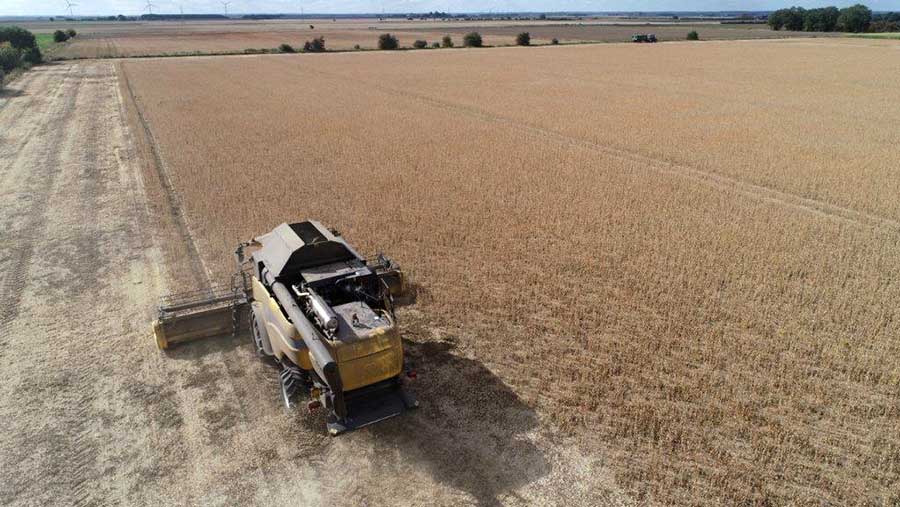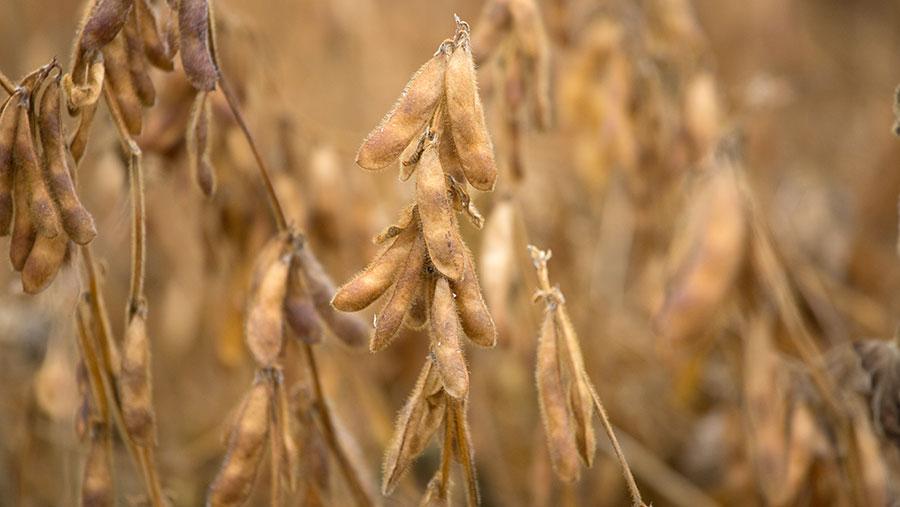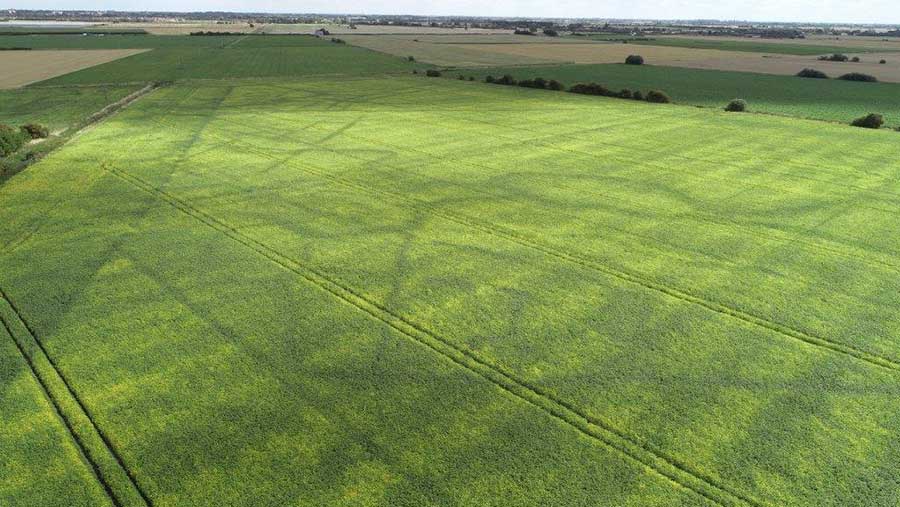Grower finds soya a good option after late-lifted sugar beet
 Andrew Branton says combining soya is like "shaving the soil"
Andrew Branton says combining soya is like "shaving the soil" South Lincolnshire grower Andrew Branton has turned to soya beans as a good crop to follow late-lifted sugar beet when there is little time to drill winter wheat.
With British Sugar extending the beet campaign by opening its factories for longer, Mr Branton sought a spring-sown break crop to enable him to lift beet later to maximise yields.
Unlike late-drilled winter wheat and some other spring crops, he says soya yields are not compromised when following late-harvested sugar beet, as the crop’s drilling window is not until the end of April/start of May.
“Soya is a crop that dovetails with growing sugar beet with a prolonged lifting season,” he tells Farmers Weekly. However, it is essential that the sugar beet harvest does not occur in poor conditions that would spoil the soil structure for the following soya crop.
See also: Dorset grower plans for second season with soya despite mediocre yield
Good break crop
Mr Branton also highlights issues with finding good break crops, when last autumn he was forced to rip up 202ha of oilseed rape because of cabbage stem flea beetle damage.
Having seen soya being grown in Argentina on a trip in 2016, he reasoned that as long as conditions were favourable, there was no reason that soya couldn’t grow well on his farm and could be that elusive break crop.
He tried out soya last year for the first time on the 2,225ha Willow Tree Farm, just south of Spalding, which he operates with his father, on soils ranging from silty clay loams to black fen peats, growing cereals, pulses, potatoes, beet and daffodils.
He drilled 50ha of the variety Siverka which produced 95t of soya, and he described this as a reasonable yield given that the wet spring led to a two-week delay planting the crop until mid-May.
As a late-drilled crop, soya gives other benefits such as effective blackgrass control, low inputs and an ability of fix its own nitrogen, while following sugar beet with soya also allows for a double cereal break prior to winter wheat.
New varieties
New soya varieties, such as Siverka and Vilshanka, have been introduced into the UK for their yield and high pod formation, but Mr Branton stresses that a level seed-bed is crucial for combining soya as there are still a number of low-lying pods.

New varieties have higher pod formation, aiding harvesting
He says harvesting soya is like “shaving the soil”, so he ploughs and then sows the crop with a Horsch power harrow-drill combination to ensure a level seed-bed. Rolling afterwards is essential.
The wet spring last year delayed drilling until 16 May. Although it was later than planned, Mr Branton does not believe the later drilling date hit the overall harvested yield.
However, like other crops on the farm, the soya was affected by the summer drought as it received only minimal rainfall during its growing period from May to its 28 September harvest.
The average yield was close to 2t/ha, falling short of the benchmark target of 2.5t/ha.
Gross margin
He described the gross margin as “not special” (see table) and added that “like all spring crops, it’s a stepping stone to a first wheat and therefore it does need to yield more to stand on its own two feet”.
Despite this, the advantages of such a low input crop are clear and if a higher yield of 2.5t/ha can be achieved, the gross margin would highlight soya’s financial potential.
Mr Branton is “encouraged to have another go, especially if you take the drought out of the equation”, and is planning to drill another 50ha this spring.

Pigeon damage is a particular problem at the cotyledon stage
One major concern for growing soya is pigeon damage, as the birds attack the crop even more than peas and oilseed rape, so Mr Branton recommends using every method available to scare off the hungry birds.
“Unlike other crops, the pigeons seemed to attack the crop for a period of two weeks. This was just after the cotyledon stage in June,” he says.
Human scarecrows
Given the intensity and timescale of the pigeon damage, Mr Branton is considering employing a team of people to walk the fields in these two weeks, acting as a human scarecrows.
He believes this would be financially viable over a two-week period if it effectively controlled the pigeon damage.
Mr Branton is aiming for higher prices this season by growing soya on a seed contract, but he also hopes there will be “more of a premium to be extracted from genuine GM-free crops”.
Currently, virtually all imported soya is genetically modified, coming from North and South America, so GM-free crops could offer a good price premium and help locally grown soya to have a more encouraging future.
Willow Tree Farm soya gross margin 2018 |
|
|
Yield |
2t/ha |
|
Value |
£370/t |
|
Total Income |
£740/ha |
|
Seed cost |
£150/ha |
|
Fertiliser cost |
£70/ha |
|
Spray cost |
£90/ha |
|
Gross margin |
£430/ha |
Soya crop area for 2019
The soya area is likely to be largely static this season, reflecting the general decline in spring-sown cropping and the big increase in the winter wheat area in the open mild autumn.
David McNaughton, director of seed supplier Soya UK, expects the area to be steady at 3,200ha this spring, but the potential for the harvested crop could be six times the 5,000t of soya harvested last summer.
He says there is increased interest in UK soya from food and animal feed companies as the crop is non-GM and can be traced back to the farm, unlike the “any-origin” open world market.
Current soya prices are about £375/t, some £50/t above the GM any-origin market, and Mr McNaughton says this market could easily expand sixfold to 30,000t in five years’ time.
Yields from last year were largely between 1.25 and 2.5t/ha, with the latter figure often taken as the target to make gross margins compete with other spring-sown break crops. Soya UK offers buy-back contracts for the crop.
It advises that soya can be grown south of a line from Humberside to Pembrokeshire with growers as far afield as South Yorkshire, Shropshire, Kent and south-west Wales.

